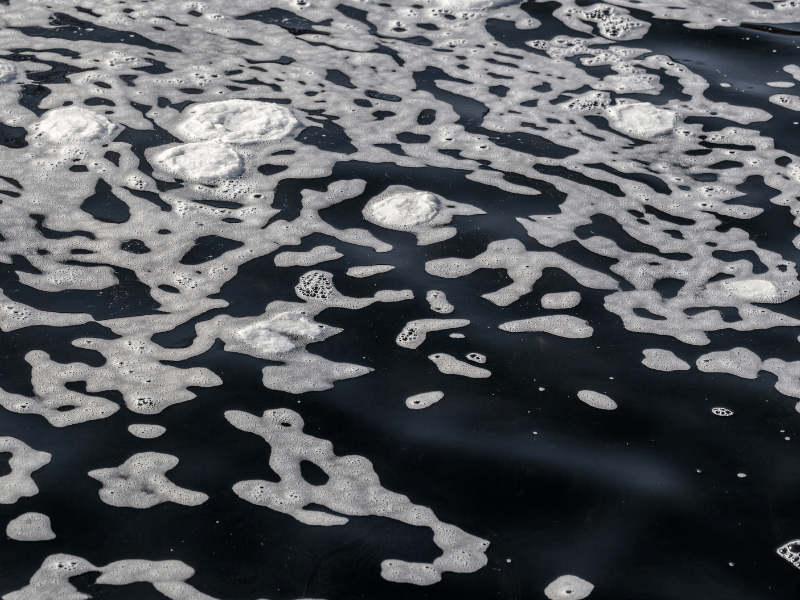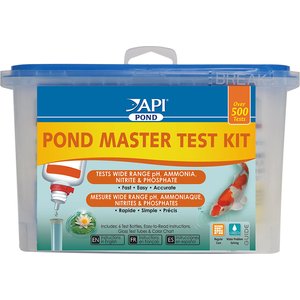Foamy Pond Water? How to Get Rid of It for Good
Pond Academy is reader-supported. Buying through links on our site may earn us an affiliate commission. As an Amazon Associate I earn from qualifying purchases.
Foamy pond water can be unsightly when it starts to spread across your pond.
And worse yet, it usually means there is an underlying issue with your pond water that you’ll need to get fixed.
Let’s take a look at what pond foam really is, why your pond might be suffering from it, and learn how to get rid of it once and for all!
What Is Pond Foam?

If your pond has a water feature, like a waterfall or fountain, then you’re probably no stranger to a little foam on the surface of your pond. This is simply small bubbles caused by water agitation and is totally normal.
However, if the foam in your pond keeps accumulating and starts to blanket the ponds surface in white foamy froth, then that’s usually a sign of a larger problem.
Pond foam itself is harmless, but those little bubbles are usually caused by an overabundance of dissolved organic carbon (DOC’s). These compounds basically reduce the surface tension of your pond, which allows air to mix with the water causing bubbles (pond foam).
High DOC levels can be dangerous to your pond’s ecosystem and deadly to your fish.
Get Our Best Pond Tips Sent to Your Inbox for Free!
Join thousands of others and learn from our decades of pond building and maintenance experience! Your pond will thank you!
By subscribing you agree to receive emails from PondAcademy.com. We will always respect your privacy and you can unsubscribe at any time.
Why Is My Pond Foamy?
So, what causes pond water to foam? Foamy water is common in ponds and water gardens stocked with fish as DOC’s often come from fish food and fish waste. If you have fish in your pond, you need to ask yourself:
- Do I have too many fish in my pond? An overabundance of fish can lead to excess fish waste in your pond which may lead to high levels of DOC’s.
- Am I overfeeding my fish? Excess fish food goes uneaten and contributes to the pond sludge problem on the bottom of your pond and you guessed it, high levels of DOC’s.
High levels of DOC’s can also come from decaying plant matter, pond muck (the sludge on the bottom of your pond), and algae blooms.
If you have so much foam that it is spilling out over the edge of your pond (see image below), then you were probably the victim of a prank (or vandalism). And it’s most likely soap bubbles, not pond foam.

So, unless you know for certain your pond is suffering from one of the above, the reason it has foam might not be obvious.
Not to worry though, as you can simply follow the steps below to get rid the of foam in your pond or water garden.
How to Get Rid Of Pond Foam Naturally
OK, so we know what pond foam is and what causes it. And even if you aren’t 100% sure why your pond is foamy, there are still certain steps we can take to help identify why and fix the problem. To effectively get rid of white foam in your pond, let's start with testing the water.
Test Water Quality
A water quality test is a great way to tell if your pond is having issues with ammonia, nitrites, pH and so on.
Decomposing matter creates ammonia and nitrites which are harmful to fish and can wreak havoc on your ponds ecosystem. In a well-balanced pond, beneficial bacteria help to break down these substances. However, if you have more organic compounds decomposing than you have beneficial bacteria to break it down, then your pond has an imbalance.
A pond water test kit can help identify what issues your pond or water garden is having and how bad they really are.
Typically, if your pond water is suddenly suffering from high ammonia and nitrite levels it’s because your pond filter isn’t keeping up, you're overfeeding your fish, and/or you have too many fish in your pond.
Pond Filter & Skimmer
Having a properly sized pond filter is key to preventing pond foam and to ensure your pond has a healthy ecosystem.
If you’re not sure if your filter is properly sized for your pond, check out our pond filter calculator to find the right-sized filter for your specific pond. It’s not uncommon for the filter to be under-sized especially when it comes to koi ponds. Koi are large fish and create a lot of waste, thus requiring a larger filter and more powerful pond pump. In addition, look for a filter that uses mechanical and biological filter media for best results.
Also, keep in mind, your filter is only as good as the media you put in it! Check out our guide to the best pond filter media on the market today to ensure you get the best filtering results.
Along with a properly sized pond filtration system, a pond skimmer can help pull off any debris and foam on the pond. This will help remove debris before it sinks and starts to decompose, a well as removing any pond foam that may have formed, giving your foam issues the one, two punch!
Fish Food
Fish food is often what causes foam in a fish pond (and a host of other problems). Too much of it and poor-quality food are both common culprits.
The protein in uneaten fish food is broken down into ammonia and nitrites (which is harmful to fish and causes foam), lowers oxygen levels, can lower pH in a pond and cause other issues with your fish.
And, unfortunately, over-feeding your fish is an easy thing to do. Feeding is a fun way to interact with your fish. Plus, when you approach your pond, often fish will swim to the surface and appear hungry, even when they aren’t.
So, to help prevent over-feeding of your pond fish, be sure to:
- Try to feed your fish on a schedule. Feed your koi or other pond fish up to 5 times daily (during warmer months) on a set schedule.
- Feed only what they eat. Be mindful of how much they eat each time you feed them. Start out with a small amount and if they eat it quickly (within a few minutes) then feed them a little more. Typically, fish will eat to satisfaction within a five-minute window. Any food still around after that 5 minutes will most likely not be eaten.
- Be aware of changing temperatures. As it gets colder, most fish will eat less as they start to enter torpor. This is a common time for pond owners to accidentally overfeed their fish. Read the directions on your specific brand of fish food for suggested feeding amounts during the colder months. And when your fish has reached torpor you will want to stop all feedings (typically below 40 degrees). Check out our guide on how to properly measure pond temperature.
An automatic pond fish feeder is a great way to make sure your fish eat on a schedule, whether your home or not, and ensure they only get the desired amount.
The quality of the food you feed your fish is also very important. Cheap foods are full of “fillers” that your fish will excrete out, and thus creating more waste and lowering water quality, stressing pond filters, and so on.
Be sure to only feed your fish high-quality food in amounts that they’ll completely consume. I recommend Kaytee Koi’s Choice Premium Fish Food.
Pond Defoamer
After you’ve performed the steps above, and hopefully fixed the root cause of the issue, we can use a pond defoamer to quickly eliminate the foam and get your pond water back to its pristine condition.
![]() Important
Important
Pond defoamer products work extremely well (and fast), but if you haven’t fixed the underlying cause of the foam, then it’s likely to keep returning. If you’re simply wanting to reduce the bubbles created from a water feature, like a waterfall, then a defoamer works great for that, as well.
Pond defoamer is an anti-foam pond treatment that when applied, quickly removes any foam in your pond or water garden.
What Is In Pond Defoamer?
The ingredients in a foam remover product will vary by brand, and some brands have proprietary blends and don’t disclose the full ingredients. However, Microbe-Lift Defoamer (our pick for best pond defoamer) is made up of simply Silicone Antifoam and water. This product is safe for fish, pond plants, birds and aquatic life.
How To Apply Defoamer To Your Koi Pond
Simply pour the pond defoaming agent directly into your pond or water garden. The amount will vary depending on the size of your pond and the product you are using. For example, when using Microbe-Lift Defoamer, you would pour 1 oz of product into your pond for every 500 gallons of pond water. If after 5 minutes you still notice foam on your pond, then repeat the dosage.










